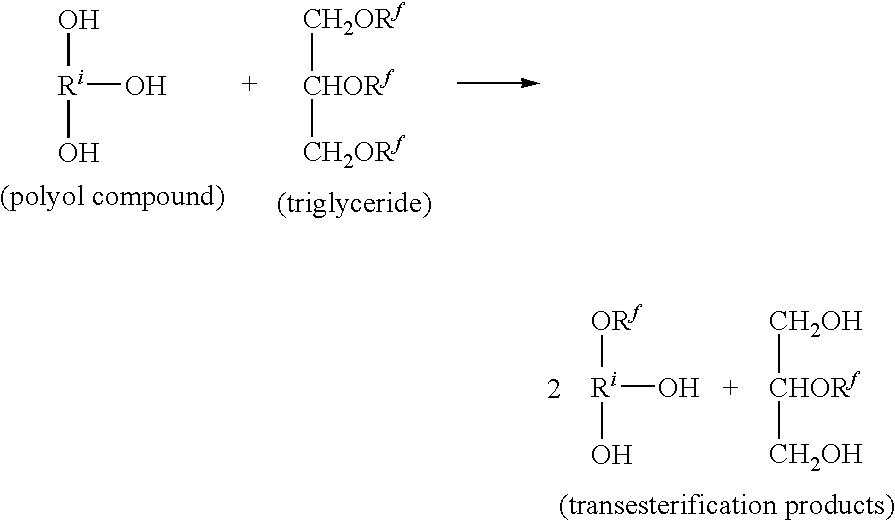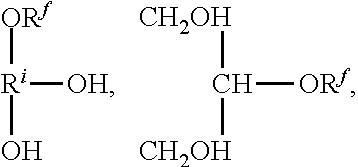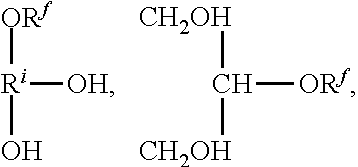Compositions containing functionalized oils and polyolefins
a technology of functionalized oils and polyolefins, applied in the direction of coatings, polyurea/polyurethane coatings, etc., can solve the problems of difficult adhesion of coatings and adhesive compositions to some plastics, such as polyolefins
- Summary
- Abstract
- Description
- Claims
- Application Information
AI Technical Summary
Benefits of technology
Problems solved by technology
Method used
Image
Examples
preparation 1
Synthesis of Functionalized Tung Oil (FTO-Ca)
[0108]Chinese tung oil (82.1 g, ˜0.088 moles), trimethylolpropane (TMP) (23.6 g, ˜0.176 moles) and 0.49 g of a calcium naphthenate catalyst containing about 5% calcium (CEM-ALL, by OMG Americas, Inc.) are charged into a reaction kettle equipped with stirrer, thermometer, nitrogen inlet, condenser and heat jacket. The mixture is heated to about 200° C. under nitrogen. When the reaction temperature reaches 70° C., an opaque homogeneous liquid mixture is formed with a light color and low viscosity. As the temperature reaches about 150° C., the liquid mixture becomes translucent with a light color. When the mixture is heated at 190-200° C. for about 15-20 minutes it becomes transparent and lightly colored. However, it becomes translucent again after cooling, indicating that the transesterification reaction has not been completed. After heating an additional 20-30 minutes at about 200° C., the liquid becomes transparent and remains transparent...
example 1
Aqueous Dispersion Composition of the Invention with Polyurethane Prepared with Functionalized Tung Oil (FTOPU) and Chlorinated Polyolefin (CPO) Dispersion (FTOPUR-CPO Dispersion)
[0109]A reaction kettle equipped with stirrer, heat jacket, thermometer, and nitrogen inlet, is charged with functionalized tung oil prepared as in Preparation 1 (FTO-Ca, functionality is 2 and equivalent weight is 199) 50 g, dimethylolpropionic acid (DMPA) 13.6 g, N-methylpyrrolidone (NMP) 8.6 g and dibutyltin dilaurate (T-12) 0.0075 g. The reaction kettle is heated under stirring with dry nitrogen to 60° C. until the DMPA is completely dissolved. The reaction kettle is then cooled to about 30° C. by stopping heat under stirring with nitrogen. Methylene bis(cyclohexamethylisocyanate) (H12MDI) 107.6 g is then added and the reaction kettle is heated to 65°-70° C. to carry out the FTO-prepolymer preparation. The temperature should be kept at 70°-74° C. to avoid possible side reaction resulting in increasing t...
example 2
Composition of the Invention without Chain Extension (Ftopu Dispersion)
[0112]This example prepares an FTOPU dispersion without chain extension. The reaction kettle is the same as the one described in Example 1. FTO-Ca (from Preparation 1) 54 g, NMP 30 g, and DMPA 18.2 g are added into the reaction kettle. The reactants are heated to about 90° C. until the DMPA particle disappears. The reaction kettle is then cooled to about 60°-65° C. to obtain the fine DMPA particles, then toluene diisocyanate (TDI) 37.8 g is slowly added to control the reaction among FTO-Ca, DMPA and TDI, which is a vigorous, exothermal reaction. The temperature is kept at 90°-95° C. and triethanolamine (TEAL) 20 g as well as NMP 24 g are added after about 30 min. to neutralize the pendant COOH-containing FTOPU product formed at NCO / OH=0.95 / 1.0. About 10-15 min later, hot water (70°-80° C.) 240 g is added to carry out the dispersion under vigorous agitation. A transparent, light brown FTOPU dispersion is obtained....
PUM
| Property | Measurement | Unit |
|---|---|---|
| softening point | aaaaa | aaaaa |
| softening point | aaaaa | aaaaa |
| softening point | aaaaa | aaaaa |
Abstract
Description
Claims
Application Information
 Login to View More
Login to View More - R&D
- Intellectual Property
- Life Sciences
- Materials
- Tech Scout
- Unparalleled Data Quality
- Higher Quality Content
- 60% Fewer Hallucinations
Browse by: Latest US Patents, China's latest patents, Technical Efficacy Thesaurus, Application Domain, Technology Topic, Popular Technical Reports.
© 2025 PatSnap. All rights reserved.Legal|Privacy policy|Modern Slavery Act Transparency Statement|Sitemap|About US| Contact US: help@patsnap.com



